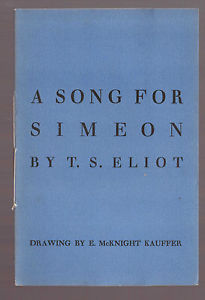
Back Una canción para Simeón Spanish Cantique pour Siméon French In Liet foar Simeon Frisian A Song for Simeon Portuguese A Song for Simeon Russian A Song for Simeon Vietnamese
| A Song for Simeon | |
|---|---|
| by T. S. Eliot | |
 The cover of the poem's first publishing, Faber and Gwyer's 1928 pamphlet | |
| Written | 1928 |
| First published in | Ariel Poems |
| Illustrator | Edward McKnight Kauffer |
| Form | Dramatic monologue |
| Meter | Free verse |
| Publisher | Faber and Gwyer |
| Publication date | September 1928 |
| Lines | 37 |
"A Song for Simeon" is a 37-line poem written in 1928 by American-English poet T. S. Eliot (1888–1965). It is one of five poems that Eliot contributed to the Ariel Poems series of 38 pamphlets by several authors published by Faber and Gwyer. "A Song for Simeon" was the sixteenth in the series and included an illustration by avant garde artist Edward McKnight Kauffer.[1] The poems, including "A Song for Simeon", were later published in both the 1936 and 1963 editions of Eliot's collected poems.[2]
In 1927, Eliot had converted to Anglo-Catholicism and his poetry, starting with the Ariel Poems (1927–31) and Ash Wednesday (1930), took on a decidedly religious character.[3] "A Song for Simeon" is seen by many critics and scholars as a discussion of the conversion experience. In the poem, Eliot retells the story of Simeon from the second chapter of the Gospel of Luke, a just and devout Jew who encounters Mary, Joseph and the infant Jesus entering the Temple of Jerusalem. Promised by the Holy Ghost that he would not die until he had seen the Saviour, Simeon sees in the infant Jesus the Messiah promised by the Lord and asks God to permit him to "depart in peace" (Luke 2:25–35).
The poem's narrative echoes the text of the Nunc dimittis, a liturgical prayer for Compline from the Gospel passage. Eliot introduces literary allusions to earlier writers Lancelot Andrewes, Dante Alighieri and St. John of the Cross. Critics have debated whether Eliot's depiction of Simeon is a negative portrayal of a Jewish figure and evidence of anti-Semitism on Eliot's part.
- ^ Eliot, T. S. "A Song for Simeon" in Ariel 16. (London: Faber and Faber, 1928).
- ^ Eliot, T. S. "A Song for Simeon" in Collected Poems: 1909–1935. (London: Faber and Faber; New York: Harcourt Brace, 1936); and Collected Poems: 1909–1962. (London: Faber and Faber; New York: Harcourt Brace, 1963).
- ^ Timmerman, John H. T. S. Eliot's Ariel Poems: The Poetics of Recovery. (Lewisburg, Pennsylvania: Bucknell University Press, 1994), 117–123.
© MMXXIII Rich X Search. We shall prevail. All rights reserved. Rich X Search